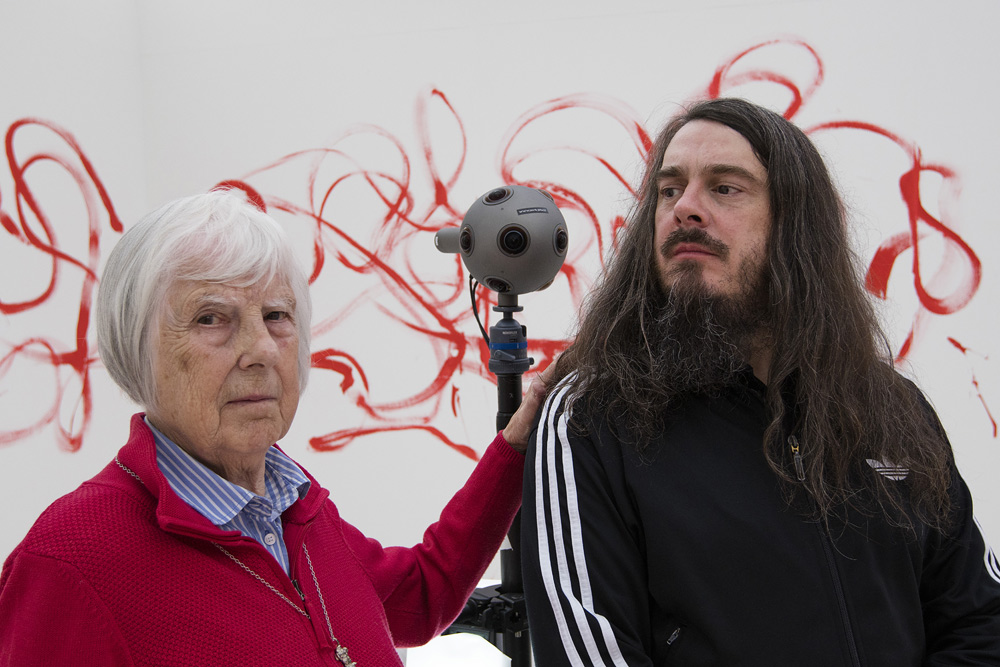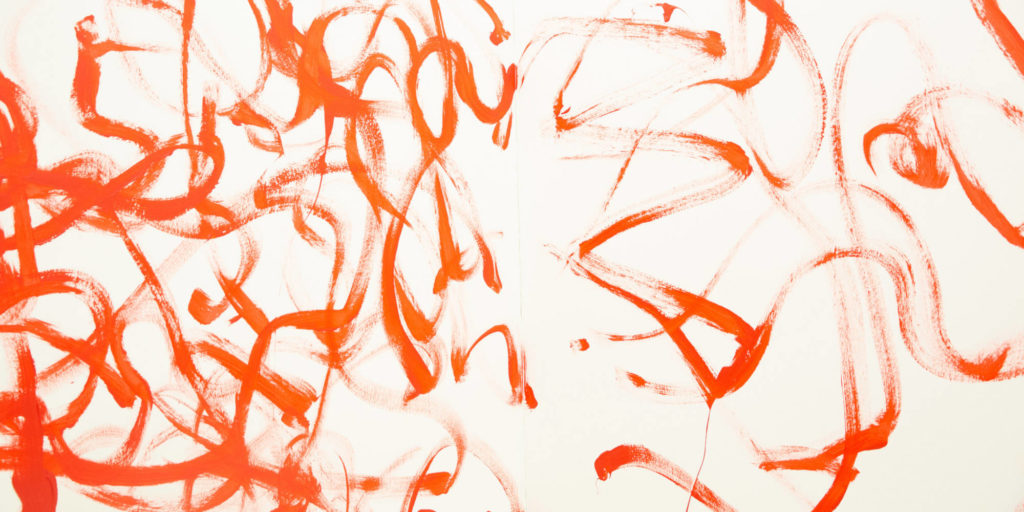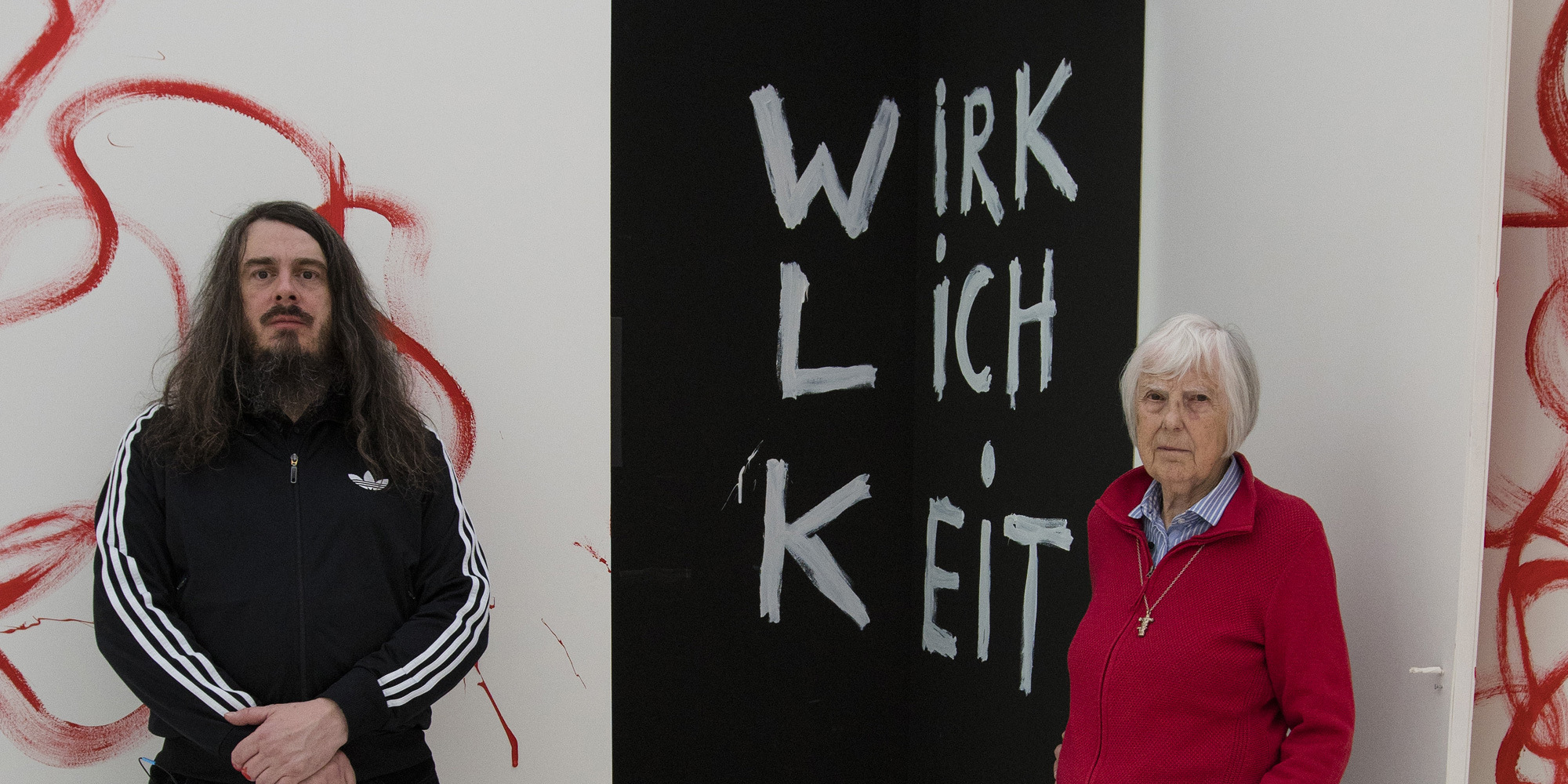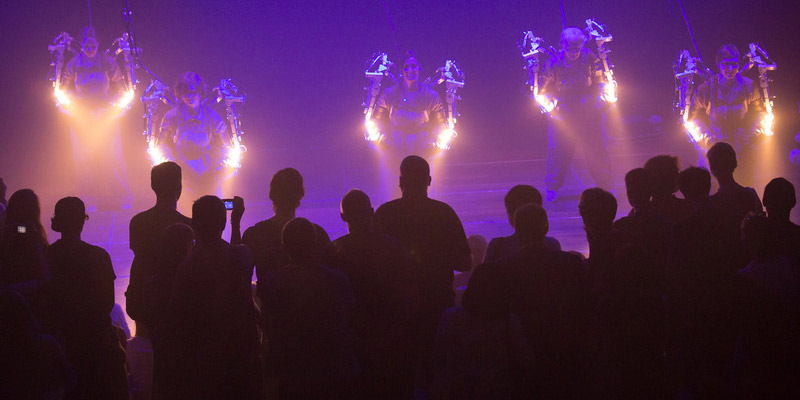360° film / installation
The first virtual reality production by Jonathan Meese and his mother Brigitte Meese is a journey into the heart of the dictatorship of art.

In the artist’s virtual studio, the spectators witness the emergence of a 360°-Gesamtkunstwerk of the future: The sleeping artist is visited by wonderful, inspiring dreams. His mother enters, brings him coffee and urges him to paint. Another Mother Meese comes in, and another, and another… and the artist paints in a frenzy of creation, because “art is just to get started, and right away it’s more awesome than Picasso” (Jonathan Meese). While Clouzot’s famous film Le mystère Picasso (1956) showed the creative act on a two-dimensional plane, here the spectators are right inside the events, entering into their mysteries. The white studio space becomes a multidimensional screen. Several mothers enter, commenting, evaluating and provoking a work that is a reflection on Alfred Hitchcock, Anthony Perkins, Richard Wagner and Joseph Beuys. It leads to a compelling insight: Everybody is an artist, at least beneath these VR-goggles.
In a cooperation project with ARTE spanning several years, Berliner Festspiele/Immersion and invited artists are exploring the potentials and limits of Virtual Reality Experience and 360° film. This technology has been inspiring game developers for years, and artists are also beginning to experiment with VR to open up and explore new spaces for art.

For the initial presentation from 21 to 29 April 2018, the room designed by Jonathan Meese will be reconstructed at Gropius Bau. Visitors will be able to witness the creation of an artwork within an artwork. From this time, the film will also be available via the free ARTE360 VR-app for iOs, Android, GearVR and Daydream as well as on ARTE’s website.
Credits:
With Brigitte Meese, Jonathan Meese
Directed by: René Päpke, Robin von Hardenberg
Concept/Idea: Jonathan Meese
Dramaturgy: Henning Nass
Dramaturgical consultation: Thomas Oberender, Jutta Wangemann
Props: Caroline Rössle-Harper
Camera: Philipp Wenning
Camera assistant: Kevin Ruhland, Mats Meisen
Music: Bernhard Lang
Editor: René Päpke
Production: Julia Schmejkal
Compositing/3-D: Paul Schunack, Alexander Court, Lukas Scholz, Dennis Röscheisen
Sound: Sven Mühlender
Technical direction: Kobalt Martin Michaels
Chief of lighting: Andreas Schwab
Lighting: Julian Lück
Berliner Festspiele/Immersion
Artistic Director: Thomas Oberender
Technical Director: Matthias Schäfer
Project Coordinator: Marie-Kristin Meier
Project Assistant: Adrian Waschmann
Technicians: Ivan Jovanovic, Sybille Casper, Mirco Neugart, Martin Zimmermann
Atelier Jonathan Meese
Coordination: Doris Mampe, Mathilde Walter
Construction and logistics: Stephan Kallage
Editorial team: Simon Ofenloch (ZDF/ARTE), Kay Meseberg (ARTE360/ARTE G.E.I.E.), Caroline Mutz(ARTE G.E.I.E.), Jochen Werner (Berliner Festspiele), Annina Zwettler (ARTE Deutschland)
“SAXOPHONE SOLO from the second act of the opera MONDPARSIFAL BETA 9–23”
Original title PARZEFOOL – DER TUMBE THOR
Music and text: Bernhard Lang
© by G. Ricordi & Co. Bühnen- und Musikverlag GmbH
With friendly permission of the Universal Music Publishing Group
A recording of Österreichischer Rundfunk (Radio Österreich 1)
Unit manager Jens Jamin (ORF)
Recording engineer Andreas Karlberger (ORF)
With thanks to Bayerische Staatsbibliothek München/Image archive
Production KOBALT Kreation, Berliner Festspiele/Immersion, ZDF/ARTE
© Kobalt Kreation | Berliner Festspiele/Immersion | ZDF/ARTE 2018
Websites:
Bio
Jonathan Meese (DE); his work follows the tradition of the Gesamtkunstwerk, including painting, sculpture, installation, performance, drawing, collage and theatre work. His participation in the 1st Berlin Biennale exhibition in 1998 earned him wide recognition for his work. In a teeming installation using materials ranging from photocopies to drawings, posters and carnival masks, which were scattered throughout the space, making it resemble a children’s playroom, he indiscriminatingly celebrated the heroes and anti-heroes of world history, mythology, film and popular culture. This made it already clear: Meese is a creator of worlds. He is constantly working on, shaping and painting a large-scale work on the authority of the arts.
The notion of the Gesamtkunstwerk, with its distinctive aspect of performative art, as well as the idea of art as a counter-world – as a “dictatorship”— has merged Meese’s work with theater from the very beginning. His space-filling installations showed his talent for theater from an early stage. In 1998, Meese was invited for the first time to design the set for Sonnenallee by the film director Leander Haußmann. In 2004 Bert Neumann and Frank Castorf invited him to the Volksbühne in Berlin. There he developed stage sets for Pitigrilli’s Kokain (2004) and three other stage productions. Meese combines painting, sculpture and installation in a unique way; genres, which he still works with separately to this day, but which he increasingly combines to form a “single, striking structure, which at the same time is a manuscript, stage, situation and costume.” (Roberto Ohrt). Jonathan Meese uses this structure to fulfil the dream of boundless art.
Meese directed a stage production for the first time in his performative theatre sculpture entitled DE FRAU. He enticed the actors to perform free improvisation, in which everyone could intervene without any specific instructions, and thus sparked a small revolution at the established ensemble theater. He designed sets for Wolfgang Rihm’s opera Dionysos, which was premiered at the Salzburg Festival 2010 under the direction of Pierre Audi, as well as the baroque opera Médée by Marc-Antoine Charpentier, also directed by Audi at the Théâtre des Champs Elysées in Paris 2012.
Jonathan Meese’s first contact with Richard Wagner’s Parsifal was in 2005 by invitation of the Berlin Staatsoper Unter den Linden. In parallel to the production of *Parsifal* on the main stage, he performed a total of five times on his own stage in the depot of the Staatsoper. Here, below the actual stage, Meese produced his own version of the opera, in which he was the stage designer and only actor with several roles. After an unsuccessful invitation in 2016 to Bayreuth, the Wagnerian temple of the muses, in 2017 Meese took on the roles of opera director, stage and costume designer of MONDPARSIFAL ALPHA 1–8 (Wiener Festwochen) and MONDPARSIFAL BETA 9–23 for the first time.


